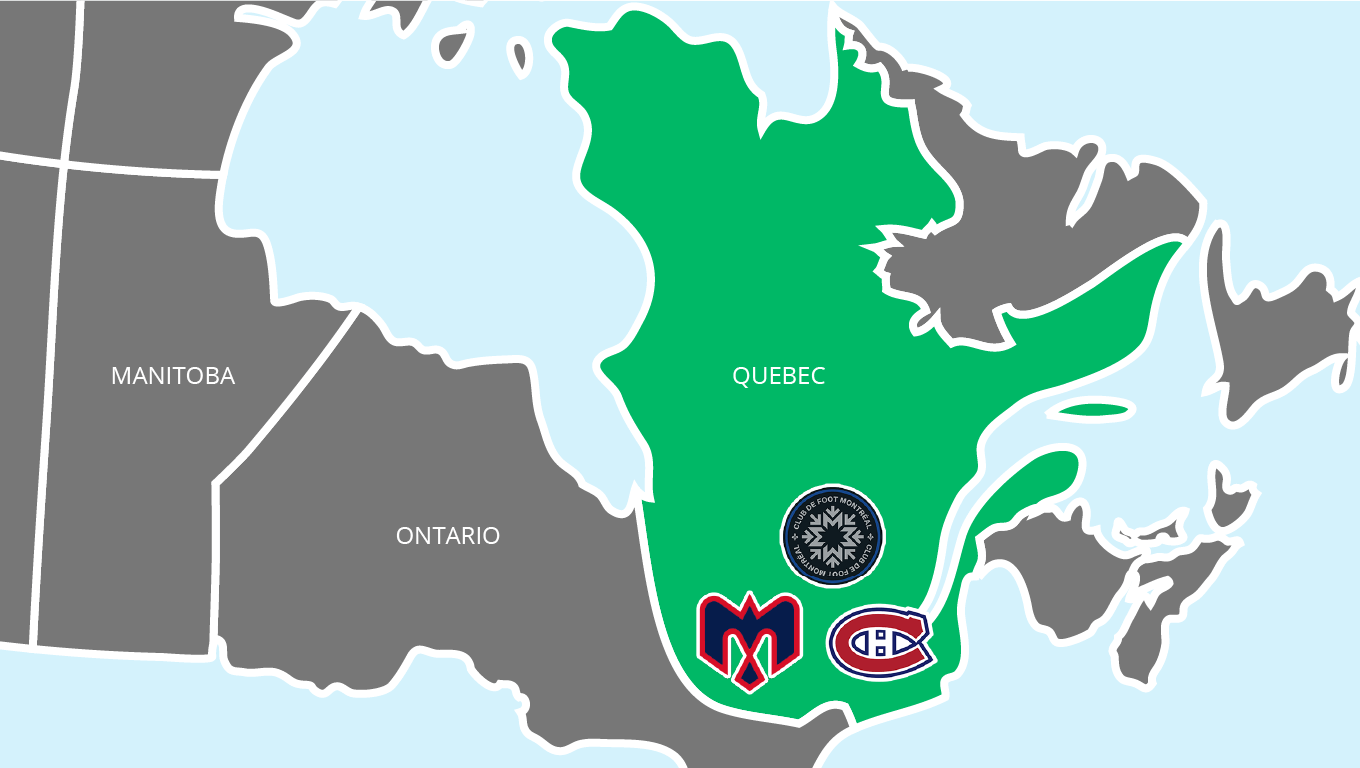Best Canada Sports Betting Sites 2025
Discover the best Canada sports betting sites in 2025. Our experts have carefully ranked and reviewed each of the licensed online sportsbooks in Canada below, helping you make informed choices.
How to Get Started With Online Sports Betting in Canada
Online sports betting is legal nationwide, with each province in Canada overseeing its own operations.
Since the 2021 passage of Bill C-218, Canadians have been free to place bets on individual games.
In Ontario, iGaming Ontario manages a strictly regulated marketplace, while other provinces operate their own government-run sites.
If you live outside Ontario, you can also use sportsbooks licensed in other jurisdictions.
Below, you’ll find only fully licensed and regulated sportsbooks, so you can bet confidently no matter where you’re located in Canada.
- 19+. T&C Apply. Play Responsibly
- 19+. T&C Apply. Play Responsibly
- 19+. T&C Apply. Play Responsibly
- 19+. T&C Apply. Play Responsibly
- 19+. T&C Apply. Play Responsibly
- 19+. T&C Apply. Play Responsibly
- 19+ T&C Apply. Play Responsibly. Full Terms Apply. This offer is not available for players residing in Ontario.
- 19+. T&C Apply. Play Responsibly
- 19+ T&C Apply. Play Responsibly. Full Terms Apply. This offer is not available for players residing in Ontario.
- 19+. T&C Apply. Play Responsibly
- 19+. T&C Apply. Play Responsibly
- 19+ T&C Apply. Play Responsibly. Full Terms Apply. This offer is not available for players residing in Ontario.
- 19+. T&C Apply. Play Responsibly
- 19+ T&C's Apply. This Offer is not available to players residing in Ontario
- 19+ T&C Apply. Play Responsibly. Full Terms Apply. This offer is not available for players residing in Ontario.
- The "Sign-up offer” promotion will run from 13:00 (CEST) on 21.09.2021 to 05:59 (CEST) on 31.12.2022 (the "Promotional Period"). This offer is not available in conjunction with any other sign-up offer. By taking part in this promotion, you hereby agree to these Specific Promotional Terms and Conditions and to our General Terms and Conditions
- 19+. T&C Apply. Play Responsibly
- 19+ T&C Apply. Play Responsibly. Full Terms Apply. This offer is not available for players residing in Ontario.
- 19+ T&C's Apply. This Offer is not available to players residing in Ontario
- 19+. T&C Apply. Play Responsibly
- 19+. T&C Apply. Play Responsibly
- 19+. T&C Apply. Play Responsibly
- 19+. T&C's apply.
- 19+. T&C Apply. Play Responsibly
- 19+. T&C Apply. Play Responsibly
- 19+. T&Cs Apply. Play Responsibly
- 19+. T&C Apply. Play Responsibly
- 19+. T&C Apply. Play Responsibly
- 19+. T&C Apply. Play Responsibly
- New Players Only. Free bet - one-time stake of $/€10, min odds 1.5, stake not returned. 1X wager the winnings. Wager from real balance first. Wager calculated on bonus bets only. Max conversion: $/€200. Valid for 7 Days from issue. Withdrawal requests voids all active/pending bonuses. Excluded Skrill deposits. Full Terms Apply 19+ #AD
- 19+. T&C Apply
- 19+. T&C Apply. Play Responsibly
- 19+. T&C Apply. Play Responsibly
- 19+ T&C Apply. Play Responsibly. Full Terms Apply. This offer is not available for players residing in Ontario.
- 19+. T&C Apply. Play Responsibly
- 19+ T&C's Apply
- 19+. T&C Apply. Play Responsibly
- 19+. T&C Apply. Play Responsibly
- 19+ T&C Apply. Play Responsibly. Full Terms Apply. This offer is not available for players residing in Ontario.
- 19+. T&C Apply. Play Responsibly
- 19+. T&C Apply. Play Responsibly
- 19+ T&C's Apply This Offer is not available to players residing in Ontario
- 19+ T&C Apply. Play Responsibly. Full Terms Apply. This offer is not available for players residing in Ontario.
- 19+ T&C's Apply. This offer is not available to players residing in Ontario
- 19+. T&C Apply. Play Responsibly
- 19+. T&C Apply. Play Responsibly
- 19+. T&C Apply. Play Responsibly
- 19+ T&C's Apply. This Offer is not available to players residing in Ontario
- 19+. T&C Apply. Play Responsibly
- 18+ T&C Apply.
Best Sports Betting Sites in Focus
At Gambling.com, we test online sportsbooks extensively and write first-hand reviews of each site, so our readers can decide if a sportsbook suits their preferences.
The list at the top of this page includes all the best new betting sites in Canada, along with links to in-depth user reviews and ratings for each site.
Below is a quick overview of some of our top picks:
TonyBet
There are lots of bonuses at TonyBet for new and returning customers.
When signing up, there's a 100% matched deposit bonus to be claimed.
The sportsbook matches your first deposit with free bets, up to a maximum value of $350.
After that, there are boosted odds on parlays every day.
We also like TonyBet's 'Forecast' promotion, which gives you the chance to win up to $1500 in free bets for correctly predicting the results of 10 sporting events.
While TonyBet could do with adding some live streaming options, it was good to see the sportsbook offering a wide selection of popular payment options.
Payouts took less than 12 hours on occasion, which is pretty quick compared to other Canadian betting sites we've reviewed. For more information about this sportsbook, read our TonyBet Canada review.
- 100% Boosts on Parlay Bets
- Forecast Game With Free Bet Prizes
- Withdrawals Processed Quickly
- Big Welcome Offer
- No Live Streaming
- No Horse Racing Betting Odds
William Hill
Founded in the UK in 1934, William Hill brings decades of experience to Canadian bettors.
When we signed up with this betting site, we got insurance on our first bet up to a value of $500 - meaning the book refunds losing bets with a free bet that equals the losing stake.
There are early payouts on soccer games if your team takes a two-goal lead, along with same-game parlay boosts for NBA games.
The 'Epic Boost' promotion, meanwhile, significantly increases the odds on popular markets.
Budget bettors will appreciate the low $5 minimum deposit limit, with payment methods like Interac catering to Canadian sports bettors.
For the full story, explore our updated William Hill Canada sportsbook review — backed by in-depth testing and analysis of our team of experts.
- Boosts on Hundreds of Markets Weekly
- Early Payouts on Soccer Games
- NHL Live Streams
- High-Value Welcome Offer
- Desktop Site Has an Old-School Look
- Lacking Promos For Popular Sports Like Hockey
Betway
Betway Video Review
With gambling licenses in multiple countries and partnerships with sports leagues and clubs like the NHL and Arsenal FC, Betway is one of Canada's most recognisable betting sites.
This is also one of the best options in Canada for Esports betting.
Betway has several promotions for returning customers. The 'Parlay Club' rewards bettors who bet $25 on parlays in one week with $10 in free bets.
NFL bettors can claim double winnings on First TD Scorer bets if their selection scores a second touchdown in a game.
We recently updated our Betway Canada review, so check it out if you want in-depth information on this site.
- Weekly Free Bet Club
- Award-Winning Esports Betting
- Partnerships With NHL & Arsenal FC
- MLB Live Streams
- Special NBA & NHL Promotions
- Not The Biggest Welcome Offer
- More F1 Betting Options Needed
Pribet
Pribet is one of the best sports betting sites for claiming free bets in Canada.
New customers can claim a welcome bonus where Pribet matches your first deposit up to a value of $100, while existing customers can also claim several free bet offers after signing up.
Our favourite is the monthly 10% deposit match bonus. If you make three deposits into your betting account within a month, Pribet will match 10% of each of your deposits with free bets.
The maximum you can claim from this offer is $75, but it's a unique deal that is worth exploring.
Pribet has several of these matched deposit offers available around specific sporting events as well.
We've claimed matched deposit offers for NHL and NFL games, as well as tennis Grand Slams like the US Open.
- Monthly Free Bets
- Broad Range of Payment Methods
- High-Value Golf Odds
- No Live Streams
- Formula 1 Odds Could be Improved
Goldenbet
Goldenbet is one of the newer names on our list of the best sportsbooks in Canada.
While there are fewer regular promotions than some other sports betting sites offer, Goldenbet still deserves its place on the list, as the available offers provide great value.
There's no shortage of events to bet on, with more than 35 sports listed on the homepage.
We took advantage of the daily 10% cashback deal when testing the site, which allows you to claim 10% back on all lost bets when you make a $100 deposit.
The Canadian Football League is well-covered (always a nice plus), with odds boosts available on certain CFL games throughout the Canadian football season.
Some users report slow withdrawals. When we tested the withdrawal process, we found that withdrawals were usually fully processed within three banking days. For further details about this sportsbook, see our Goldenbet Canada review.
- Daily Cashback Offer
- CFL Odds Boosts
- Regular Free Bets
- Better Tennis Odds Elsewhere
- No Live Streams
Best Sports Betting Sites in Focus
At Gambling.com, we test online sportsbooks extensively and write first-hand reviews of each site, so our readers can decide if a sportsbook suits their preferences.
The list at the top of this page includes all the best new Canada betting sites and Canada sports betting apps, along with links to in-depth user reviews and ratings for each site.
Below is a quick overview of some of our top picks:
BetMGM
As the official sports betting partner of the NFL, BetMGM is among Canada's best NFL betting sites, offering exclusive markets and experiences to football bettors.
Aside from NFL, the sportsbook has markets for all the sports you'd expect, with live streaming options on select events, including NBA basketball games.
Same-game parlays can be placed on nine different sports, which is an impressive amount.
During testing of the site, funds were received in under eight hours when withdrawing money from BetMGM.
There's no customer care number, but an attentive support team can be reached 24/7 through live chat and email, in case you have any questions.
We recently updated our BetMGM review with an in-depth look at everything this betting site offers - so take a look if you need more information.
- NBA Live Streams
- Withdrawing Funds Takes Less Than 8 Hours
- Official NFL Betting Partner
- Same-Game Parlay For 9 Sports
- No Phone Support
- Need Funds in Account to Watch Live Streams
Caesars Sportsbook
Caesars Entertainment is well-known in Ontario thanks to the Caesars Windsor Hotel & Casino. The company also has an impressive online sports betting platform.
Caesars offers NFL live streaming, allowing you to watch games on a Sunday while placing your wagers.
Caesars is also an official betting partner of the NBA, bringing market-leading odds and exclusive NBA betting content to the table for Ontario bettors.
One of the best features of Caesars Sportsbook is its integration with a variety of online gambling options.
While most online sportsbooks have an associated online casino, Caesars is also connected to the World Series of Poker (WSOP) network.
You can take your winnings from betting on over 30 different sports and use them to enter poker rooms and play against other Ontario-based poker players.
Some Canadian betting sites have more payment options than Caesars. However, the most popular methods are covered, so this won't be an issue for most.
- Outstanding NBA Odds
- NFL Live Streams
- World Series of Poker Integration
- Limited Payment Options
- Could Add More Soccer Markets
DraftKings
DraftKings Sportsbook has been operating in Ontario since April 2022 and is one of the most recognisable names in online sports betting for a reason.
We like how this betting site provides a daily fantasy sports product, as well as tips and advice for bettors through the DK Network.
One of the most unique elements of this sportsbook is the DraftKings Social feature, which allows you to follow the activity of other bettors.
All major sports leagues come with a wide range of betting options and same-game parlay lines. For example, NHL games have upwards of 180 betting markets on average.
- Wide Range of Sports Betting Options
- Lots of Player Props
- Daily Fantasy Betting
- Great Site For NHL Wagering
- Tricky to Navigate Desktop Site
- More CFL Betting Options Would be Welcome
bet365
Since launching in 2000, bet365 has grown into one of the world's most popular online sportsbooks, serving over 90 million bettors globally.
More than 600,000 events are streamed live every year for bet365 members, with a range of live betting markets available to access while you watch games.
The same-game parlay here covers 14 sports, more than you'll find at any other sportsbook available in Ontario.
bet365 has also partnered with Bayes Esports, an Esports statistics company, to bring betting lines for competitive video gaming to the regulated Ontario betting market.
You'll find a wide range of payment methods available for deposits and withdrawals, like Interac and Instadebit. We've found that bet365 usually processes withdrawal requests in 1-4 hours.
Our bet365 review was recently rewritten following extensive real user testing, so check it out for all the latest information.
- 600,000 Events Streamed Live on Site Per Year
- Withdrawals Processed in 4 Hours
- Lots of Payment Options
- User-Friendly Betting App
- Same-Game Parlay Covers 14 Sports
- Android App Not as Good as iPhone Version
- Site Could be Confusing at First For Beginners
PointsBet
PointsBet might be one of the best-connected sportsbooks in Canada, holding official sports betting partnerships with the NFL, Club Link, Curling Canada and Maple Leaf Sports & Entertainment.
When testing this betting site, we bet on exclusive markets for games involving the Maple Leafs, Raptors, Argonauts and Toronto FC.
The 'Points Betting' feature makes this site unique.
Instead of fixed losses and rewards, with points betting your profits depend on the accuracy of your prediction.
For example, if you back the over with a total points bet, you'll earn more depending on how many points are scored, once this gets over the line set by the sportsbook.
For parlay bettors, the 'Quick Parlay' tab is a standout feature. This allows you to add markets together in a few clicks and place parlays with ease.
- Unique Points Betting Options
- Maple Leaf Partnership
- 'Quick Parlays' Feature
- Dated Desktop Site
- Points Betting Can Carry Additional Risk
PowerPlay
PowerPlay Sports has a fast and easy-to-navigate desktop and mobile sports betting platform.
If you're a soccer fan, you'll see more competitions covered here than most Canadian sportsbooks offer.
If there's a league or cup competition to bet on somewhere in the world, PowerPlay will have odds for it.
You can deposit and withdraw at PowerPlay using Interac, Visa, Mastercard and Paysafecard.
While some bettors may be disappointed that PayPal is not supported, the site welcomes MuchBetter payments, which aren't widely accepted by online sportsbooks in Ontario.
- Extensive Soccer Markets
- Instant Withdrawals
- Multiple Customer Support Channels
- No Mobile App
- Streaming Unavailable
- PayPal Can't be Used to Deposit
BetRivers
The BetRivers sportsbook has some nice touches that help it stand out from other betting sites.
For example, an up-to-date 'Bet Feed' shows recent winning bets.
There are plenty of live streams to watch while you bet, including MLB streams. Global tennis, soccer and basketball games are also available to watch live.
In 2024, BetRivers partnered with NASCAR, so you'll find plenty of betting options here for NASCAR races, if that's your thing.
- MLB Live Streams
- 'Bet Feed' Shows Recent Winning Bets
- Soccer Live Streams
- Smaller Range of Sports Than Other Sites
- More Same-Game Parlay Options Needed
BetVictor
BetVictor is one of the best sports betting sites in Canada due to the value of the odds here.
Our price comparison tests have shown that BetVictor consistently offers some of the best odds for hockey, baseball, basketball, football, soccer and horse racing.
NFL betting options are plentiful, with the biggest playoff and Super Bowl games averaging 260 different markets to bet on.
Withdrawals from the site take between one and five days, depending on what payment method you're using. Credit cards, debit cards, PayPal, Neteller, Skrill and Apple Pay are all available to use.
As a site with heritage in the UK, soccer betting options are plentiful, particularly for same-game parlay bets on a variety of leagues, including the MLS and EPL.
Our BetVictor - updated for December 2025 - includes up to date info on the apps key features.
- High-Value Betting Odds
- Loyalty Rewards
- Trusted Brand With a Rich History
- Website Layout is Slightly Dated
- Some Withdrawals Can Take 5 Banking Days
Bwin
Bwin has been around since 1997 and previously sponsored soccer giants Real Madrid.
The sportsbook is powered by Entain, a well-respected firm that operates a number of big international betting brands.
Bwin's 'Parlay Generator' is impressive. This feature generates a parlay bet for you based on the sort of odds you want to take, which is handy whenever you need some inspiration for a bet.
During the NFL season, you can tick an option only to include NFL games in the parlay builder, with dozens of potential parlays provided each Sunday.
While live streaming is less extensive here, international tennis and basketball games do come with HD streams.
- Parlay Generator Tool
- Top Soccer Betting Option
- Long-Established, Reputable Brand
- Lacks Esports Betting Options
- Could Add More CFL Markets
- Focus on Soccer Won't Suit Everyone
888sport
888sport has enjoyed strong growth since launching in Canada and has been the official sports betting partner of the CFL since 2023, providing bettors with great odds for Canadian football games.
The sportsbook boasts a number of impressive features, including the 'Made For You' tab, where the bookie offers recommendations based on your betting activity.
We also like the 'BetFeed' feature, which lists the most popular wagers placed by other bettors, so you can get inspiration for your next bet if needed.
You can even organise that feed by sport or bet type to simplify things further.
- Tailored Betting Suggestions
- Official CFL Partnership
- Standout CFL Odds
- Never Stuck For Betting Options
- Payout Speeds Could be Improved
- Android App Not Rated as Highly as iOS Version
NorthStar Bets
NorthStar Bets is a site suited to both beginners and experienced bettors.
The sportsbook releases tips for major sports leagues like the MLB and provides beginner guides and quizzes to help newcomers learn how to bet.
There is also handy information about player injuries across various sports, which you can filter to find the news needed to help with your bets.
This online sportsbook supports a range of payment providers, including Canadian favourites like iDebit and Interac, as well as American Express, which isn't accepted at many other Canadian betting sites.
Live streams would take this site to the next level, so we'll be keeping tabs to see if NorthStar adds them at any point.
- Sports Insights & Picks Blog
- Instant Player Injury Info
- Accepts American Express
- No Live Streaming
- Some Markets Hard to Locate
Pinnacle
Pinnacle comes with over 25 years of experience in sports betting and this shows in a robust online sports betting platform.
Little user-friendly touches like the option to switch to dark mode help to set this site apart.
If you want advice to support your betting, visit Pinnacle's Betting Resources page.
Here, you'll find predictions for the latest events, podcasts, videos, and various calculators you can use to work out profit, margin and odds.
Pinnacle Sportsbook offers Esports betting as well, with the book running a dedicated Esports hub with all the latest events, odds, stats and live streams, for an immersive video-game betting experience.
There is also a dedicated Esports betting blog with tips and advice for betting on video games.
- Esports Betting Hub
- Betting Tools & Calculators
- Free Betting Tips & Insights
- No Mobile App
- Other Sites Have More MLS Odds
LeoVegas Sport
LeoVegas has expanded its sports betting site for Canadian bettors.
This is one of the best betting sites for soccer fans.
There are exclusive markets and promotions available when betting on teams that the site sponsors, like Wolverhampton Wanderers in the English Premier League and Atalanta in Italy's Serie A.
If we're focusing solely on appearance, LeoVegas is one of the more dated-looking betting sites, but it still runs smoothly and is easy to navigate, especially on mobile.
In fact, this sportsbook has always taken a completely mobile-first approach and users clearly appreciate this, with the site averaging a 4.7/5 user rating from over 2,000 user reviews on the App Store.
- Partnerships With Major Soccer Clubs
- Extensive Soccer Markets & Great Odds
- Boosts on Parlays
- Slightly Dated Website
- Very Few Live Streams
BET99
BET99 aims to provide a different experience to other betting sites in Canada with unique features.
For example, the sportsbook is partnered with the NHL and has a free game called 'NHL PrePlay'.
The game uses data from NHL Edge, which tracks statistics and asks general prediction questions that bettors need to answer in order to win.
This is a site based in Canada, with the tagline being 'By Canadians, For Canadians', so it should come as no surprise that they prioritise hockey betting.
There are live streams of NFL games throughout the regular season and postseason as well.
The selection of payment methods at BET99 could be more comprehensive, although you can use trustworthy payment providers like Interac, Instadebit, Visa, Mastercard and PayPal.
- Canadian Sportsbook Aimed at Canadian Bettors
- NBA & NHL Betting Partner
- Free 'NHL Edge' Game
- NFL Live Streams
- No Mobile Apps
- Withdrawals Could be Processed Faster
- Global Sports Can Sometimes Lack Markets
Sports Interaction
Launched in 1997, Sports Interaction was one of the first online sportsbooks available in Canada.
The site has a series of CFL partnerships, teaming up with the Hamilton Tiger-Cats, Winnipeg Blue Bombers, Ottawa Redblacks, and the Edmonton Elks.
You'll find exceptional odds when betting on any of these teams, using Sports Interaction's desktop or mobile platforms (there is no mobile app).
Sports Interaction is one of the best sports betting sites for live betting, with an abundance of daily live markets for sports like tennis, hockey and soccer.
Live streaming integrates seamlessly with live betting, with no lag as you switch between markets and place wagers.
- Lots of Sports Streamed Live
- Partnerships With CFL Teams
- Home-Grown, Ontario-Based
- Official NHL Betting Partner
- Could Add More Futures Markets
- Withdrawals Take 3-5 Days
- Early Cash Out Limited to Certain Markets
Why Trust Our Canada Sports Betting Sites Reviews?
We’ve been testing and reviewing sports betting sites since 2006.
Our global team of over 600 experts signs up, deposits, places bets, checks bonuses and tests withdrawals on every site to make sure only secure, reputable sportsbooks earn a spot on our list.
We also factor in real user feedback - ratings and comments from bettors like you - to capture the full picture.
Combined with our strict editorial standards, this process guarantees unbiased, accurate recommendations.
When you use Gambling.com, you skip the guesswork and go straight to trusted sites that deliver a safe, smooth and rewarding betting experience - so you can bet with confidence.
How we Rank Canadian Betting Sites
In order to properly rate and rank online sportsbooks, we use a strict betting site reviews process that involves putting each site's features to the test.
The process involves:
- Checking the site's security and licensing details
- Signing up and depositing money
- Analysing and comparing odds
- Claiming promotions
- Placing multiple bets
- Testing customer support
- Testing mobile and desktop platforms
- Withdrawing funds
Once the site has been tested, it's time to assign an overall rating.
We consider these 10 key categories when rating a site, assigning a score out of 10 in each category:
- Sports & Markets
- Betting Tools
- Payments
- Customer Support
- Reputation & User Feedback
- Site User Experience
- Mobile Features
- Responsible Gambling
- Live Betting Features
- Value of Odds
The final rating is calculated by adding up the scores from all categories and dividing that figure by 10.
Sports Betting Options at Canadian Betting Sites
Canadian betting sites — along with the best sports betting apps Canada players use — offer odds on a wide variety of sports, including major leagues like the NHL, NFL, MLB, NBA, CFL, and MLS.
Some also feature non-sports markets such as entertainment and politics betting, depending on provincial laws.

NHL Hockey Betting
Hockey is Canada’s most popular sport, and all of the best NHL betting sites offer comprehensive NHL betting options. Bettors can also find odds on Canadian junior leagues like the OHL, WHL, and QMJHL.

CFL Football Betting
Betting on the Canadian Football League is a staple, especially leading up to the Grey Cup. Expect markets such as point spreads, moneylines, totals, and player props. For more, see our guide to CFL betting sites.

NFL Football Betting
The NFL draws massive betting interest. Top sportsbooks provide extensive markets including props, futures, and live betting. For the full list, explore the best NFL betting sites.

NBA Basketball Betting
NBA games, particularly those featuring the Toronto Raptors, are heavily featured. Many platforms also offer markets on international leagues. Discover the NBA betting sites with top coverage.

Soccer Betting
The best soccer betting sites offer markets on hundreds of leagues, with the English Premier League leading in popularity. Expect options like double chance, both teams to score, and same-game parlays. MLS and Canadian national team matches are also well covered.

MLB Betting
MLB games come with deep market variety, including player props and in-game stats. Visit our top-rated MLB betting sites for more details.
How Sports Betting Works in Each Province
Single-game sports betting is legal across Canada since 2021.
However, it is up to each province or territory to create their own gambling laws. As a result, specific rules vary from province to province.
Let's look at the status of sports betting in each of Canada's provinces and territories, so you know where you stand, no matter where you're based:
Alberta
While PlayAlberta is currently the only government-run sportsbook in Alberta, Albertans can also access international sportsbooks operating in a legal grey area.
That landscape is set to change, as Alberta Gaming, Liquor and Cannabis plans to license more operators following the passing of Bill 48 - potentially creating a market similar to Ontario’s.
This shift promises stronger consumer protections, increased betting options, and more competition. It's expected that a regulated online sports betting market will be launched in 2026.
British Columbia
Currently, PlayNow BC is the only British Columbia sportsbook site licensed and regulated in the province.
That said, BC residents can still access international sportsbooks licensed elsewhere.
Major North American betting platforms like FanDuel and DraftKings remain exclusive to Ontario, and there’s been no indication that BC lawmakers plan to expand licensing beyond PlayNow BC.
Manitoba
The Manitoba sports betting setup mirrors BC’s, with PlayNow Manitoba as the only regulated Manitoba sportsbook. This betting site has been operated by Manitoba Liquor and Lotteries since 2013.
While the province may eventually license more operators, Manitobans can currently access and wager at internationally licensed sportsbooks.
New Brunswick
The Atlantic Lottery Corporation regulates gambling in New Brunswick and runs the Pro Line betting site.
However, residents can still access sportsbooks licensed outside the province. Given New Brunswick’s smaller population, a major influx of locally licensed operators seems unlikely.
Newfoundland & Labrador
Sports betting in Newfoundland and Labrador mirrors New Brunswick’s, with Pro Line - run by the Atlantic Lottery Corporation - the only regulated option. Bets can be placed online or at local retailers.
Again due to a small population, the province isn’t a major target for sportsbook expansion. Nonetheless, residents can still access internationally licensed betting sites.
Northwest Territories
The Western Canada Lottery Corporation regulates gambling in the Northwest Territories and runs Sport Select - the only locally regulated sports betting site.
Sport Select offers limited markets, mainly on baseball, basketball, football, hockey, and soccer.
Nova Scotia
Nova Scotia sports betting sites are regulated by the Atlantic Lottery Commission, which runs the Pro Line Stadium site.
Pro Line offers a simplified experience with fewer markets, making it better-suited for beginners.
Despite Nova Scotia’s strong betting culture, the province is unlikely to begin licensing additional operators anytime soon.
Nunavut Betting Sites
Sport Select, operated by the Western Canada Lottery Corporation, is Nunavut’s only regulated sports betting site.
It offers basic betting options for sports like hockey, baseball, and basketball, but falls short compared to internationally licensed sportsbooks also available to Nunavut residents.
Given the territory is a relatively small market, regulatory changes are unlikely.
Ontario Betting Sites
In 2022, Ontario became the first province in Canada to issue sports betting licenses to multiple operators.
As of 2025, 49 online sportsbooks are licensed to operate in Ontario.
These include big global betting brands like FanDuel, BetRivers, bet365, and PointsBet. These sites are regulated by the Alcohol and Gaming Commission of Ontario and overseen by iGaming Ontario.
Sports betting in Ontario is largely based on the United States model.
To bet using Ontario sportsbooks, you must be within Ontario's borders. Those outside of Ontario are blocked.
Prince Edward Island Betting Sites
Prince Edward Island is another province under the Atlantic Lottery Corporation's purview, meaning PEI punters can bet through the ALC's Pro Line Stadium.
Online sportsbooks like BetVictor and William Hill are accessible in PEI and tend to have more betting options, better odds, and extra features like cash out and live streaming.
In short, they offer a superior sports betting experience.
Quebec Sports Betting

For over two decades, Mis-O-Jeu has been the sole regulated Quebec sports betting site.
The site offers a solid range of betting options, though its design feels outdated.
That said, Quebec bettors can also access more advanced platforms licensed outside the province.
Saskatchewan Sports Betting
It took a long time, but bettors finally have a regulated Saskatchewan sports betting site.
In 2022, the province launched its PlayNow platform, the same as in British Columbia. It is regulated by the Saskatchewan Indian Gaming Authority.
Yukon Betting Sites
Unlike other Canadian provinces and territories, Yukon does not have any regulated online sportsbooks.
Again, you're dealing with an extremely small population here and a miniscule sports betting market.
However, if you are one of the few people betting on sports in The Yukon, you can access sites from betting companies licensed elsewhere.
Popular Bet Types at Top Canadian Sportsbooks
The best Canadian betting sites offer a wide variety of ways to wager. Here are the most common bet types you'll encounter:
- Moneyline: Pick the outright winner of the game.
- Point Spread: Bet on whether a team wins or loses by a set margin.
- Totals (Over/Under): Wager on the combined score being over or under a number set by the sportsbook.
- Player Props: Bet on individual player achievements, like goals or rebounds.
- Game Props: Bet on game-specific events (e.g., yellow cards, corner kicks).
- Winning Margin: Predict how much a team will win by.
- Period/Quarter/Half Bets: Bet on outcomes during specific parts of a game.
- Alternative Lines: Adjust spreads or totals to increase or decrease your risk and reward.
How to Deposit & Withdraw at Canadian Sportsbooks
Before you place a bet, you’ll need to fund your account. Here are the most popular payment options available at top Canadian betting sites:
- Credit/Debit Cards: Visa & Mastercard accepted almost everywhere. Instant deposits; some sites don’t allow withdrawals back to credit cards.
- Interac: Widely accepted, secure, and perfect for both deposits and withdrawals.
- PayPal: Convenient but less widely supported; good for deposits and occasional withdrawals.
- Apple Pay/Google Pay: Great for mobile users. Fast deposits; usually no withdrawals.
- Skrill/Neteller: Fast e-wallets popular for both deposits and withdrawals.
- MuchBetter: Mobile-focused and made for betting. Quick, secure, and increasingly accepted.
- Paysafecard: Prepaid and private. Deposit-only.
- Bank Transfer: Good for large transactions. Slower, but reliable for both deposit and withdrawal.
Responsible Gambling Online
Safety, security, and responsible gambling should always be a priority when choosing between betting sites.
All licensed sportsbooks should offer help and support for any of their customers who are struggling to stay in control of their gambling.
These sites provide tools such as deposit and wager limits, reality checks, cooling-off periods, and self-exclusion. These tools can help you stay in control by budgeting, monitoring your gambling time, and preventing the dangerous action of chasing losses.
However, should you wish to seek independent help for gambling-related harm, there are several organisations you can turn to for support, advice and information, as outlined below:
National Gambling Support Services
Gambling Therapy is an international online resource providing free support for problem gamblers worldwide, including Canadians. It offers live chat support, a support group forum, and self-help tools.
Provincial Gambling Support Services
Each province in Canada has specific gambling support services tailored to the needs of their residents. The AHS Addiction Helpline for example, is a toll-free, 24/7 helpline offering support for problem gamblers and those affected by gambling addiction in Alberta.
Self-Exclusion Programs
Most provinces and territories in Canada offer self-exclusion programs where bettors can voluntarily ban themselves from gambling at certain venues or online platforms. OLG My PlayBreak is available for Ontario bettors for example, with further options in other Canadian territories.
Counselling & Treatment Programs
Organisations like CAMH offer a specialised gambling addiction treatment program that includes counseling, psychotherapy, and support for problem gamblers.
The Final Word on The Best Sports Betting Sites in Canada
Selecting the right online sportsbook can take your experience from good to great.
Our carefully curated list of Canada’s top betting sites is the result of rigorous testing and in‑depth reviews.
To ensure you always have the latest information, our experts continually monitor each platform’s odds, markets, features, and promotions - updating this guide on a regular basis.
For the latest recommendations, bookmark this page and check back in regularly.
Frequently Asked Questions About Sports Betting in Canada
Is sports betting legal in Canada?
Yes, online sports betting is legal in Canada. Following the passing of Bill C-218 in 2021, provinces and territories have the authority to regulate single-event sports betting. Ontario, for example, launched its regulated market in April 2022, allowing private operators to offer online sports betting services.
What sports can I bet on in Canada?
You can bet on a wide range of sports, including:
- Hockey (NHL, CHL, international)
- Football (CFL, NFL, college)
- Basketball (NBA, NCAA, international leagues)
- Baseball (MLB and more)
- Soccer (MLS, EPL, Champions League, etc.)
- Golf, Tennis, UFC, and even esports
Some sportsbooks also offer non-sport markets like politics and entertainment betting, depending on provincial regulations.
Is it safe to bet online in Canada?
Yes - if you're using a licensed and regulated sportsbook. Stick with operators approved by local regulators (like iGaming Ontario) or reputable international sites that follow strict security and fairness protocols. Look for features like:
- SSL encryption
- Independent audits
- Responsible gambling tools
- Transparent terms and conditions
Do online sportsbooks in Canada accept American Express?
Some online sportsbooks in Canada accept American Express (Amex), but it's less common compared to Visa or Mastercard. Many sportsbooks prefer other payment methods like e-wallets or bank transfers. If you prefer using Amex, it's important to check the specific sportsbook's payment options to confirm its acceptance.
Where is sports betting legal?
Single-game sports betting has been legal in Canada since 2021, so Canadians are free to place bets online once they meet minimum age requirements. Before Bill C-218 was passed in 2021, sports betting was limited to parlays only. Ontario became the first province to put a sophisticated regulatory framework in place in 2022, with other provinces, like Alberta expected to follow suit in the coming years,
Can I use PayPal for sports betting?
Yes, some Canadian sportsbooks accept PayPal, especially those regulated in Ontario. It’s a convenient and secure payment method, ideal for users who prefer not to share their banking details directly.
However, availability varies, so always check the payment options of each sportsbook before signing up. Note that PayPal is typically available for both deposits and withdrawals where supported.
Can I bet with DraftKings in Canada?
Yes, but only in Ontario. DraftKings is licensed to operate in Ontario’s regulated iGaming market. If you're located in another province or territory, DraftKings is not currently available due to local regulations.
In those areas, you’ll need to use other sportsbooks that are licensed either provincially or internationally. Always check your local laws and the site’s availability in your region.












































































